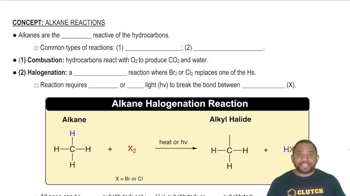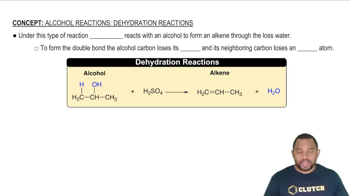Write a balanced chemical equation for the reaction that occurs when (b) silver(I) oxide decomposes into silver metal and oxygen gas when heated (c) propanol, C3H7OH(l) burns in air (d) methyl tert-butyl ether, C5H12O(l), burns in air.
Ch.3 - Chemical Reactions and Reaction Stoichiometry
Chapter 3, Problem 22a
Balance the following equations and indicate whether they are combination, decomposition, or combustion reactions: a. PbCO3(s) → PbO(s) + CO2(g)
 Verified step by step guidance
Verified step by step guidance1
Step 1: Identify the type of reaction. In this case, the reaction is a decomposition reaction. This is because a single compound (PbCO3) is breaking down into simpler substances (PbO and CO2).
Step 2: Balance the equation. Start by balancing the elements that appear in only one compound on each side. In this case, we can start with Pb. There is one Pb atom on both sides, so it is already balanced.
Step 3: Next, balance the carbon atoms. There is one carbon atom on both sides, so it is also already balanced.
Step 4: Finally, balance the oxygen atoms. There are 3 oxygen atoms on the left side (from PbCO3) and 3 on the right side (1 from PbO and 2 from CO2), so they are also balanced.
Step 5: Check your work. The balanced equation is PbCO3(s) → PbO(s) + CO2(g), and all atoms are balanced on both sides of the equation. Therefore, the equation is correctly balanced.

Verified video answer for a similar problem:
This video solution was recommended by our tutors as helpful for the problem above.
Video duration:
55sWas this helpful?
Key Concepts
Here are the essential concepts you must grasp in order to answer the question correctly.
Balancing Chemical Equations
Balancing chemical equations involves ensuring that the number of atoms for each element is the same on both sides of the equation. This is based on the law of conservation of mass, which states that matter cannot be created or destroyed in a chemical reaction. Balancing is crucial for accurately representing the reaction and predicting the amounts of reactants and products.
Recommended video:
Guided course

Balancing Chemical Equations
Types of Chemical Reactions
Chemical reactions can be classified into several types, including combination, decomposition, and combustion reactions. A combination reaction occurs when two or more substances combine to form a single product. A decomposition reaction involves a single compound breaking down into two or more simpler products, while combustion reactions typically involve a substance reacting with oxygen to produce heat and light, often resulting in carbon dioxide and water.
Recommended video:
Guided course

Common Types of Alkane Reactions
Decomposition Reactions
Decomposition reactions are a specific type of chemical reaction where a single compound breaks down into two or more simpler substances. This process often requires energy input, such as heat, light, or electricity. In the given equation, PbCO3 decomposes into PbO and CO2, illustrating this concept as it transitions from one compound to multiple products.
Recommended video:
Guided course

Alcohol Reactions: Dehydration Reactions
Related Practice
Textbook Question
Textbook Question
Balance the following equations and indicate whether they are combination, decomposition, or combustion reactions: (a) C3H6(s) + O2(g) → CO2(g) + H2O(l)
2
views
Textbook Question
Balance the following equations and indicate whether they are combination, decomposition, or combustion reactions: (b) NH4NO3(s) → N2O(g) + H2O(g) (c) Zn(OH)2(s) → ZnO(s) + H2O(l) (d) Ag2O(s) → Ag(s) + O2(g)
2
views
Textbook Question
Determine the formula weights of each of the following compounds: e. benzaldehyde, C6H5CHO, the molecule largely responsible for the odor of almond extract.
Textbook Question
Calculate the percentage by mass of oxygen in the following compounds: a. morphine, C17H19NO3
